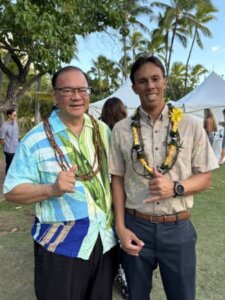Restoring ʻĀina, Restoring Ourselves
by OHA Trustee Keli‘i Akina, Ka Wai Ola, November 1, 2025
Last month, I had the privilege of representing the Office of Hawaiian Affairs (OHA) at Mālama ʻĀina Kākou, a benefit hosted by the Hawaiʻi Land Trust (HILT). The event reminded me that land in Hawaiʻi is not just something we own. It is part of who we are. ʻĀina feeds us, connects us to our past, and shapes our future.
As I listened to stories of conservation and community care, I thought about OHA’s kuleana as a landholder. We must ask ourselves: How can our lands better serve our people today?
OHA’s strategic plan, Mana i Mauli Ola, calls us to that very purpose. It prioritizes the restoration of cultural sites and traditional food systems. This work helps strengthen our communities and cultivates resilience. When we care for our land and culture, we care for our health, identity, and future.

Trustee Keli‘i Akina and ‘Olu Campbell, president and CEO of Hawai‘i Land Trust, at the Mālama ‘Āina Kākou event on Oct. 4, 2025. – Courtesy Photo
Across Hawaiʻi, many lands remain unused. Some belong to OHA, others to families or nonprofits. When land is idle, we lose more than income. We lose the chance to grow food, teach future generations, and restore balance to our environment. These neglected spaces can also attract invasive species, dumping, and increase the risk of wildfires.
One powerful way to restore land is through agriculture. Hawaiʻi currently imports most of its food. That leaves our families vulnerable to high prices and supply shortages. But our kūpuna once sustained large populations by farming in ways that worked with the land. We can learn from those systems and adapt them to meet today’s needs.
Revitalizing farming empowers local families to work the land, cultivate prosperity, and nourish their communities in ways that honor both heritage and innovation.
Bringing agriculture back to OHA lands offers far more than economic potential – it represents an opportunity to flourish. When our people can rely on the land to meet the most basic need of nourishment, we create the foundation for something greater: the ability to heal and thrive.
True flourishing arises when essential needs are met, giving one the ability to live with purpose. Restoring food security allows Native Hawaiians to reach higher levels of wellbeing – to create, to innovate, and to fulfill their potential as individuals and as a lāhui.
That’s why I am encouraged by OHA’s new Kūlana ʻĀina program. This initiative supports farmers, food workers, and chefs. It helps them find good jobs and grow their businesses. It also invests in training and development.
Combined with the thoughtful use of our legacy lands, this program can help build a new generation of food leaders connected to place and culture.
As an OHA trustee, I am committed to expanding the use of our lands for agriculture. This is about more than farming. It’s about helping our people reconnect with their roots. It’s about building strong communities and honoring the land as a living part of our identity.
By investing in food systems, OHA can help create a more self-sufficient Hawaiʻi. A Hawaiʻi where the land supports us, and we support the land. If we do this work with care and commitment, our legacy lands can truly live up to their name – for the benefit of our lāhui now and into the future.